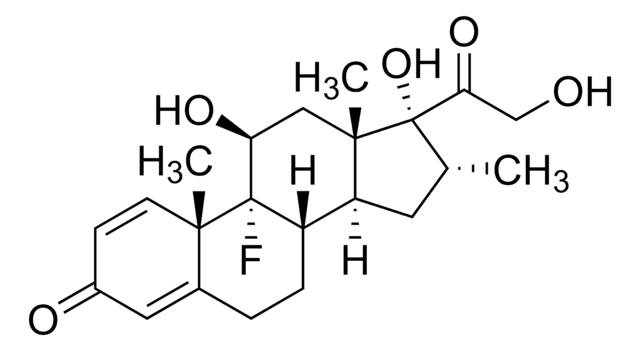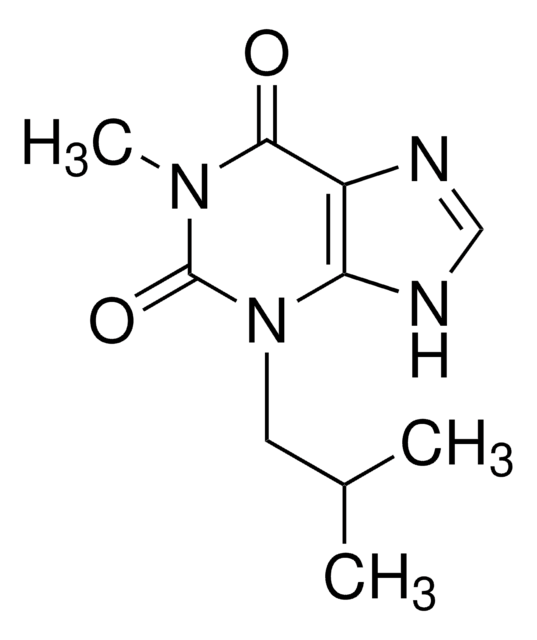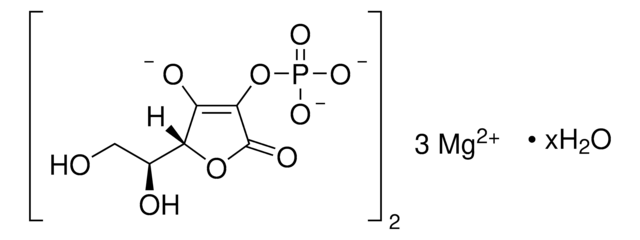Recommended Products
manufacturer/tradename
Chemicon®
Quality Level
technique(s)
cell based assay: suitable
detection method
colorimetric
General description
Obesity is a significant clinical problem that contributes to life-threatening diseases such as diabetes and atherosclerosis. The process of adipogenesis, the formation of adipose tissue, has become better understood by the study of several cell types that can be induced to undergo differentiation into adipocytes. The first, and best characterized, model of adipogenesis in vitro is the 3T3-L1 cell line, a substrain of Swiss 3T3 mouse cell line (Kehinde and Green, 1974). 3T3-L1 cells propagated under normal conditions have a fibroblastic phenotype. However, when treated with a combination of dexamethasone, isobutylmethylxanthine (IBMX or MIX) and insulin, 3T3-L1 cells adopt a rounded phenotype and within 5 days begin to accumulate lipids intracellularly in the form of lipid droplets (Figure 1; Rubin et al., 1978). Another cell line, 3T3-F442A, is blocked from differentiating at a later stage, and requires only insulin to differentiate.
The biochemical pathways of adipogenesis have become increasingly well understood with the use of the 3T3-L1 model (reviewed in Gregoire et al., 1998; Rosen et al., 2000). Treatment of cells with dexamethasone activates the transcription factor CCAAT/enhancer-binding protein b (C/EBPb). IBMX inhibits soluble cyclic nucleotide phosphodiesterases and results in increased intracellular cAMP levels (Elks and Manganiello, 1985). At the nuclear level, treatment with IBMX results in activation of the related transcription factor C/EBPd. C/EBPb and d in turn induce transcription of C/EBPa and PPARγ. Within 3 days of exposure to inducers, the cells undergo two rounds of mitosis, termed mitotic clonal expansion, which are required for differentiation (Tang et al., 2003). Insulin or insulin-like growth factor-1 promote adipocyte differentiation by activating PI3-kinase and Akt activity. Modulation of the activity of the forkhead transcription factor Foxo1 appears to be necessary for insulin to promote adipocyte differentiation (Nakae et al., 2003). C/EBPa and PPARγ direct the final phase of adipogenesis by activating expression of adipocyte-specific genes, such as fatty acid synthetase, fatty acid binding protein, leptin and adiponectin.
Endogenous negative regulators of adipocyte differentiation, such as Pref-1 and Wnt-10b, are highly expressed on undifferentiated 3T3-L1 cells, and are down-regulated upon addition of adipogenesis inducers (Ross et al., 2000; Mei et al., 2002). In addition, cytokines such as tumor necrosis factor alpha (TNFa) and transforming growth factor beta (TGF-b) interfere with adipocyte differentiation (Gregoire et al., 1998).
The identification of regulators of adipogenesis raises the prospect of preventing or reversing obesity through pharmacological means. PPARγ has received particular attention as a target, as it is essential for the final phase of adipocyte differentiation and is a pharmacological target for the thiazolidinedione class of antidiabetic drugs. The pro-adipogenic effect of the thiazolidinediones has led to interest in identifying compounds that retain antidiabetic activity without promoting adipogenesis. In addition, inhibitors of PPARγ activity have been identified that inhibit adipogenesis, and might serve as the basis for development of effective anti-obesity drugs (Wright et al., 2000; Camp et al., 2001).
The biochemical pathways of adipogenesis have become increasingly well understood with the use of the 3T3-L1 model (reviewed in Gregoire et al., 1998; Rosen et al., 2000). Treatment of cells with dexamethasone activates the transcription factor CCAAT/enhancer-binding protein b (C/EBPb). IBMX inhibits soluble cyclic nucleotide phosphodiesterases and results in increased intracellular cAMP levels (Elks and Manganiello, 1985). At the nuclear level, treatment with IBMX results in activation of the related transcription factor C/EBPd. C/EBPb and d in turn induce transcription of C/EBPa and PPARγ. Within 3 days of exposure to inducers, the cells undergo two rounds of mitosis, termed mitotic clonal expansion, which are required for differentiation (Tang et al., 2003). Insulin or insulin-like growth factor-1 promote adipocyte differentiation by activating PI3-kinase and Akt activity. Modulation of the activity of the forkhead transcription factor Foxo1 appears to be necessary for insulin to promote adipocyte differentiation (Nakae et al., 2003). C/EBPa and PPARγ direct the final phase of adipogenesis by activating expression of adipocyte-specific genes, such as fatty acid synthetase, fatty acid binding protein, leptin and adiponectin.
Endogenous negative regulators of adipocyte differentiation, such as Pref-1 and Wnt-10b, are highly expressed on undifferentiated 3T3-L1 cells, and are down-regulated upon addition of adipogenesis inducers (Ross et al., 2000; Mei et al., 2002). In addition, cytokines such as tumor necrosis factor alpha (TNFa) and transforming growth factor beta (TGF-b) interfere with adipocyte differentiation (Gregoire et al., 1998).
The identification of regulators of adipogenesis raises the prospect of preventing or reversing obesity through pharmacological means. PPARγ has received particular attention as a target, as it is essential for the final phase of adipocyte differentiation and is a pharmacological target for the thiazolidinedione class of antidiabetic drugs. The pro-adipogenic effect of the thiazolidinediones has led to interest in identifying compounds that retain antidiabetic activity without promoting adipogenesis. In addition, inhibitors of PPARγ activity have been identified that inhibit adipogenesis, and might serve as the basis for development of effective anti-obesity drugs (Wright et al., 2000; Camp et al., 2001).
Application
Research Category
Cell Structure
Cell Structure
The Adipogenesis Assay provides a convenient format for induction & analysis of adipogenesis in the classic 3T3-L1 model.
The Chemicon Adipogenesis Assay provides a convenient format for induction and analysis of adipogenesis in the classic 3T3-L1 model. The most commonly used inducers of adipogenesis, dexamethasone, IBMX and insulin, are provided in convenient, ready-to-use formulations. In addition, reagents for staining of differentiated adipocytes are provided to allow the investigator to obtain quantitative information about inducers and inhibitors of adipogenesis. A solution of Oil Red O is used to stain lipid droplets in mature adipocytes. A wash solution is provided to remove free Oil Red O from the cell layer. Also included is Dye Extraction Solution that extracts lipid-bound Oil Red O for measurement in a spectrophotometer (Figure 2).
Components
IBMX Solution - (Catalog No. 90355) - One vial containing 250 μl of 0.5 M 3-isobutyl-1-methylxanthine (IBMX) in DMSO.
Insulin Solution - (Catalog No. 90356) - One vial containing 250 μl of 10 mg/mL recombinant human insulin.
Dexamethasone Solution - (Catalog No. 90357) - One vial containing 100 μl of 10 mM dexamethasone in ethanol.
Oil Red O Solution - (Catalog No. 90358) - One bottle containing 60 mL 0.36% Oil Red O solution in 60% isopropanol.
Wash Solution - (Catalog No. 90360) - Two bottles containing 250 mL each of wash solution.
Dye Extraction Solution - (Catalog No. 90359) - One bottle containing 30 mL of dye extraction solution.
Insulin Solution - (Catalog No. 90356) - One vial containing 250 μl of 10 mg/mL recombinant human insulin.
Dexamethasone Solution - (Catalog No. 90357) - One vial containing 100 μl of 10 mM dexamethasone in ethanol.
Oil Red O Solution - (Catalog No. 90358) - One bottle containing 60 mL 0.36% Oil Red O solution in 60% isopropanol.
Wash Solution - (Catalog No. 90360) - Two bottles containing 250 mL each of wash solution.
Dye Extraction Solution - (Catalog No. 90359) - One bottle containing 30 mL of dye extraction solution.
Storage and Stability
Note: Kit components require two different storage temperatures.
Dexamethasone Solution, IBMX Solution and Insulin Solution should be stored at -20ºC. Oil Red O Solution, Wash Solution, and Dye Extraction Solution should be stored at room t
Dexamethasone Solution, IBMX Solution and Insulin Solution should be stored at -20ºC. Oil Red O Solution, Wash Solution, and Dye Extraction Solution should be stored at room t
Legal Information
CHEMICON is a registered trademark of Merck KGaA, Darmstadt, Germany
Disclaimer
Unless otherwise stated in our catalog or other company documentation accompanying the product(s), our products are intended for research use only and are not to be used for any other purpose, which includes but is not limited to, unauthorized commercial
signalword
Danger
Hazard Classifications
Aquatic Acute 1 - Aquatic Chronic 2 - Eye Dam. 1 - Flam. Liq. 2 - Repr. 1B - STOT SE 2 - STOT SE 3
target_organs
Central nervous system, Eyes,Central nervous system
wgk_germany
WGK 3
flash_point_f
48.2 °F
flash_point_c
9 °C
Certificates of Analysis (COA)
Search for Certificates of Analysis (COA) by entering the products Lot/Batch Number. Lot and Batch Numbers can be found on a product’s label following the words ‘Lot’ or ‘Batch’.
Already Own This Product?
Find documentation for the products that you have recently purchased in the Document Library.
Our team of scientists has experience in all areas of research including Life Science, Material Science, Chemical Synthesis, Chromatography, Analytical and many others.
Contact Technical Service









